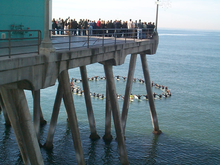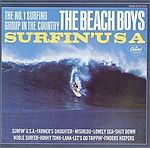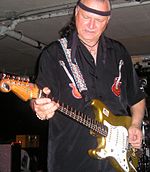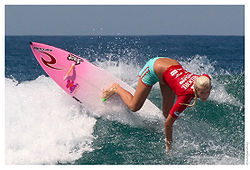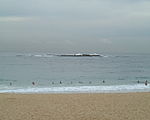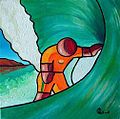- Surf culture
-
Surf culture includes the people, language, fashion and life surrounding the art of surfing.
The culture began early in the 20th century, spread quickly during the 1950s and 1960s, and continues to evolve. It affected fashion, music, literature, films, jargon, and more. Surfers, who come from many walks of life, are bound by the hunt for great waves, the desire for the ultimate ride, and life in and around the ocean.
The fickle nature of weather and the ocean, plus the great desire for the best possible types of waves for surfing, make surfers dependent on weather conditions that may change rapidly. Surfer Magazine, founded in the 1960s when surfing had gained popularity with teenagers, used to say that if they were hard at work and someone yelled "Surf's up!" the office would suddenly be empty. Also, since surfing has a restricted geographical necessity (i.e. the coast), the culture of beach life often influenced surfers and vice versa. Localism or territorialism is a part of the development of surf culture in which individuals or groups of surfers designate certain key surfing spots as their own.[1]
Aspects of 1960s surf culture in Southern California, where it was first popularized, include the woodie[2], bikinis[3] and other beach wear, such as boardshorts or baggies,[4] and surf music.[5] Surfers developed the surfboard to be able to "surf" on land;[6] and a number of other boardsports. Of these the most popular being snowboarding and skateboarding, in addition to other spin-offs that have grown out of the sport ever since.[7]
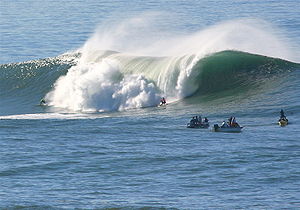 Surfers and spectators in boats at Mavericks, a world-renowned big wave break a half mile off the coast of Half Moon Bay, California
Surfers and spectators in boats at Mavericks, a world-renowned big wave break a half mile off the coast of Half Moon Bay, California
Contents
Big Wave culture
A non-competitive adventure activity involving riding the biggest waves possible (known as "rhino hunting") is also popular with some surfers. A practice popularized in the 1990s has seen big wave surfing revolutionized, as surfers use personal watercraft to tow them out to a position where they can catch previously unrideable waves (see tow-in surfing). These waves were previously unrideable due to the speed at which they travel. Some waves reach speeds of over 60 km/h; personal watercraft enable surfers to reach the speed of the wave thereby making them rideable. Personal watercraft also allow surfers to survive wipeouts. In many instances surfers would not survive the battering of the "sets" (groups of waves together). This spectacular activity is extremely popular with television crews, but because such waves rarely occur in heavily populated regions, and usually only a very long way out to sea on outer reefs, few spectators see such events directly.
Though surfers come from all walks of life, the basis of the beach bum stereotype comes from that great enthusiasm that surfers can have for their sport. Dedication and perfectionism are also qualities that surfers bring to what many have traditionally regarded as a commitment to a lifestyle as well as a sport.[8]
For specific surf spots, the state of the ocean tide can play a significant role in the quality of waves or hazards of surfing there. Tidal variations vary greatly among the various global surfing regions, and the effect the tide has on specific spots can vary greatly among the spots within each area. Locations such as Bali, Panama, and Ireland experience 2-3 meter tide fluctuations, whereas in Hawaii the difference between high and low tide is typically less than one meter.
Each surf break is different, since the underwater topography of one place is unlike any other. At beach breaks, the sandbanks can change shape from week to week, so it takes commitment to get good waves (a skill dubbed "broceanography" by a few California surfers[who?]).
The saying "You should have been here yesterday," became a commonly used phrase for bad conditions.[citation needed] Nowadays, however, surf forecasting is aided by advances in information technology, whereby mathematical modelling graphically depicts the size and direction of swells moving around the globe.
The quest for perfect surf has given rise to a field of tourism based on the surfing adventure. Yacht charters and surf camps offer surfers access to the high quality surf found in remote, tropical locations, where tradewinds ensure offshore conditions.
Along with the rarity of what surfers consider truly perfect surf conditions (due to changing weather and surf condition) and the inevitable hunt for great waves, surfers often become dedicated to their sport in a way that precludes a more traditional life. Surfing instead, becomes their lifestyle.
The goals of those who practice the sport vary, but throughout its history, many have seen surfing as more than a sport, as an opportunity to harness the waves and to relax and forget about their daily routines. Surfers have veered from even this beaten path, and foregone the traditional goals of first world culture in the hunt for a continual 'stoke', harmony with life, their surfing, and the ocean. They; these "Soul Surfers", are a vibrant and long-standing sub-group.[9][8][10] Competitive surf culture, centered around surf contests and endorsement deals, and localism's disturbance of the peace, are often seen in opposition to this.[8]
The historic surf village of Ocean Beach, San Diego, California, is a good example of a place devoted to the surfing lifestyle, having been introduced originally by OB Lifeguard George Freeth.[11][12]
Localism
Even though waves break everywhere along a coast, good surf spots are rare. A surf break that forms great surfable waves may easily become a coveted commodity, especially if the wave only breaks there rarely. If this break is near a large population center with many surfers, territorialism often arises. Regular surfers who live around a desirable surf break may often guard it jealously, hence the expression "locals only." The expression "locals only" is common among beach towns, especially those that are seasonally encroached upon by vacationers who live outside the area. Localism is expressed when surfers are involved in verbal or physical threats or abuse to deter people from surfing at certain surf spots. It is based in part on the belief that fewer people mean more waves per surfer.
Some locals have been known to form loose gangs that surf in a certain break or beach and fiercely protect their "territory" from outsiders.[1] These surfers are often referred to as "surf punks" or "surf nazis." The local surfer gangs in Malibu and on Hawaii, known as da hui, have been known to threaten tourists with physical violence for invading their territory. In Southern California, at the Venice and Santa Monica beaches, local surfers are especially hostile to the surfers from the San Fernando Valley whom they dub "vallies" or "valley kooks". The expression "Surf Nazi" arose in the 1960s to describe territorial and authoritarian surfers, often involved in surf gangs or surf clubs. The term "Nazi" was originally used simply to denote the strict territorialism, violence and hostility to outsiders, and absolute obsession with surfing that was characteristic in the so-called "surf nazis." However, some surfers reclaimed and accepted the term, and a few actually embraced Nazism and Nazi symbolism. Some surf clubs in the 1960s, particularly at Windansea in La Jolla, used the swastika symbol on their boards and identified with Nazism as a counter culture (though this may have just been an effort to keep out or scare non-locals.) The "locals only" attitude and protectionism of the Santa Monica surf spots in the early 1970s was depicted in the movie Lords of Dogtown, which was based on actual events.
Localism often exists due to socioeconomic factors as well. Until relatively recently, surfers were looked down upon as lazy people on the fringe of society (hence the term "beach bum.") Many who surfed were locals of beach towns who lived there year-round, and were from a lower economic class. For that reason as much as any other, these groups were resentful of outsiders, particularly those who were well-to-do and came to their beaches to surf recreationally rather than as a way of life. Australia has its own history where surfers were openly treated with hostility from local governments in the sport's early days, and the tension never really went away, despite the sport's enormous increase in popularity. Maroubra Beach in Australia became infamous for localism and other violence chronicled in the documentary film Bra Boys, although the surfers in the film maintain they are not a "gang."
Surf Gangs
Surf gangs often form to preserve cultural identity through the protection of beach towns and shorelines. If known territory is trespassed by members of another surf gang, violence usually occurs. Long Beach is home to one of the oldest and biggest surf gangs, called "Longos." Some surf gangs have been known to not only claim land territory, but also claim specific surfing waves as territory. Surf gangs have gained notoriety over the years, especially with the production of Bra Boys.
Cito Rats
The “Cito Rats” are a territorial surfer clique that was formed in Montecito, California around 1978 and 1979. It all started with a group of friends who were surfers and wanted a beach of their own. A founding member called the group the “Cito Rats”.
The Cito Rats have a handful of beaches that they feel are their domain and use intimidation to enforce this claim. These territories include the beaches of The “Biltmore” Pier, Dorbo Dunes, Chicken Creek, Pigion Ridge, The Underground, Miramar, Hammonds reef, Nuns, “The Rock”, The Shooting Range, Rancho Coyote, The Herb Estate and RKL. According to sources,[who?] the extremist and craziness of the Rats were very prevalent during the 1980s and into the early 1990s. By the mid 1990s, the founding members pulled back on the extremism of the gang. No longer were they getting into trouble.
The gang has since died out and no new members have been added in over 10 years.
Wolfpak
The Wolfpak is so named "because we run in a pack, working together. When you mess with one of us, you mess with all of us.” –Kala Alexander''[13]
The Wolfpak was originally composed of a few select surfers from Kauai, Hawaii who believed in respecting localism.[14] Kauai, according to a Wolfpak member, is a place where one is raised to honor the value of respect. If you don’t show respect, then you can’t expect anyone to return the favor.[15] This value is what led to the group’s effort to manage the chaos associated with North Shore surfing. Some of the members of this group are pro surfers Andy Irons and Bruce Irons, as well as the reality show 808 star and Blue Crush actor, Kala Alexander.[16]
Wolfpak began in 2001 when leader Kala Alexander moved to North Shore in search for job opportunities, and found disorganization and lack of respect in the surf lineup at surf reef break, Pipeline. Alexander found it necessary to dictate some sort of organization in who would surf the Pipeline to both preserve the value of showing respect to one’s elders, i.e. those who were native to the land and had been surfing for many years, and also protect surfers from the reef’s potentially life threatening waves.[17]
The waves at Pipeline can reach over 20 feet and its powerful disposition has taken the lives of professional surfers. If a visiting surfer dropped in on another surfer, unknowing of the wave’s nature, he could cause serious harm or death to the former. On a related note, some surfers aren’t ready to handle Pipeline. These observations led to the Wolfpak’s proactive enforcement on the North Shore.[18]
The Wolfpak’s ways of preventing the aforementioned consequences of Pipeline popularity have gotten attention through their violent means. In an incident where a tourist cut off a friend of Alexander’s in a dangerous six-foot swell, the Wolfpak leader beat up the visitor for his poor decision and later reflected on the positive outcomes native enforcement could bring.[19] Comments from anonymous locals show that the presence of Wolfpak is well perceived, if not intimidating. Though, some locals who hold similar values of cultural respect support what the members are trying to do.[20]
Alexander doesn’t view Wolfpak as a gang, but says they look out for every local Hawaiian. Embedded in the brotherhood’s philosophy is respect for others. They attempt to preserve this way of life and realize the implications that a lack of respect can have on Hawaiian culture.[21]
"I don't care if it's Kauai or Brooklyn. And I believe wherever you go, locals have the right of way. That's how it should be, and how it used to be here."- Kala Alexander[22]
Bra Boys
The Bra Boys are a popular surf gang founded in Maroubra, Australia. They established international fame and attention in 2007 with the release of Bra Boys: Blood is Thicker than Water, a documentary about the bonds and struggles of the many gang members. The Bra Boys name originates both from the slang word for brother, and as a reference to the gangs suburb, Maroubra.[23] Gang members tattoo "My Brothers Keeper" across the front of their chests and the Maroubra area code across their back.
Many of the Bra Boys came from impoverished homes and families torn apart by drug use. Sunny, Jai, Koby and Dakota Abberton, the brother who first founded the gang, came from an especially difficult upbringing. To them the Bra Boys were much more than a gang, they were a group of friends, a family of their own that loved to surf and always stood up for each other.[24] The documentary, written and directed by the gang members themselves, showed the raw gritty side of a surf life previously glamorized by Hollywood.[25]
Surf terminology
Main article: List of surfing terminologySurfing (particularly in Southern California) has its own slang, which has comingled with Valspeak. Words like "dude", "tubular", "radical", and "gnarly" are associated with both. One of the primary terms used by surfers around the world is the word "stoked". This refers to a mixed feeling of anxiety and happiness towards the waves breaking.
Surfers have often been associated with being slackers or 'beach bums' (with women being known as 'beach bunnies').
The shaka sign, associated with Hawaii, origins unknown,[27][28] is a common greeting in surfer culture.[26]
Issues affecting surfers
Global warming, environmental damage, and increasing riparian development may continue to increase pressure on the sport. Oil spills and toxic algae growth can threaten surfing regions.
Some of these stresses may be overcome by building of artificial reefs for surfing. Several have been built in recent years (one is at Cables in Western Australia), and there is widespread enthusiasm in the global surfing community for additional projects. However, environmental opposition and rigorous coastal permitting regulations is dampening prospects for building such reefs in some countries, such as the United States.
Spirituality
Many surfers combine their love of the sport with their own religious or spiritual beliefs. In Huntington Beach, California for example, a local Christian, non-denominational church occasionally meets on the beach for Sunday early-morning services. After the closing prayer, the minister and his congregation paddle out for a morning session. In addition, many surfing communities organize and take part in memorial services for fallen surfers, sometimes on the anniversary of passing such as the Eddie Aikau memorial service held annually at Waimea Bay, Hawaii. Participants in the memorial service paddle out to a suitable location with flower leis around their necks or with loose flowers (sometimes held between their teeth)., The participants then get into a circular formation, hold hands, and silently pray. Sometimes they will raise their clasped hands skyward before tossing their flowers or leis into the center of the ring. Afterward, they paddle back toward the beach to begin their surf session. Often these services take place at sunrise or sunset. In locations with a pier, such as Huntington Beach, Orange County, California, the service can take place near the end of the pier so that any non-surfers, such as elderly relatives, can watch and participate. Often the participants on the pier will throw down bouquets of flowers into the center of the ring.
The most extended treatment of surfing as a form of nature religion was written by Bron Taylor in an academic journal in 2007,[citation needed] which led to a good deal of discussion in surfing magazines. Taylor discussed surfing in more detail, as well as other spiritualities of belonging and connection to nature, in Dark Green Religion: Nature Spirituality and the Planetary Future.[29]
Surfing art
Surf music
Surf culture is reflected in surf music, with sub-genres such as surf rock and surf pop. This includes works from such artists as Jan and Dean, The Beach Boys, The Surfaris ("Wipe Out!"), Dick Dale, The Shadows, and The Ventures. The music inspired dance crazes such as The Stomp, The Frug, and The Watusi. While the category surf music helped popularize surfing, most surfers at the time, such as Miki Dora, preferred R&B and blues[citation needed]. A newer wave of surf music has started in the acoustic riffs of artists such as Jack Johnson and Donavon Frankenreiter, who are both former professional surfers.
Surf rock
- Wedding Cake Island, Midnight Oil, 1975.
- Reef
- Paddle Out by Sublime
- The Ziggens
Surf pop
- Middle man (song by Jack Johnson)
- Surfer Girl (single), The Beach Boys, 1963.
- Surf City, Jan and Dean, 1963.
- Surfer Joe, The Surfaris, 1963.
- He's my blonde headed stompie-wompie real gone surfer boy, Little Pattie, 1963.
- Fun Fun Fun, The Beach Boys, 1964.
- Surf Song, Fenix*TX, 1999.
- Surfpop (album), Drifting Sand, 1999.
Instrumental
- Dick Dale, 1960s to present.
- Walk Don't Run, The Ventures, 1960.
- Apache, The Shadows, 1960.
- Bombora (single), The Atlantics, 1963.
- Wipe Out, The Surfaris, 1962.
- The Blue Stingrays, 1997.
- Bullwinkle Part II, The Centurions, 1964.
- "Needles on the Beach", Tin Machine
- The Break, Rob Hirst, Martin Rotsey, Jim Moginie (ex Midnight Oil) and Brian Ritchie (ex Violent Femmes) - 2010.
Surf visual art
Many people have incorporated the free spirited and hippie nature of many surfing lifestyles into their paintings and murals such as the Surfing Madonna mosaic in Encinitas.
Fashion
Surfwear is a popular style of casual clothing, inspired by surf culture. Many surf-related brand names originated as cottage industry, supplying local surfers with boardshorts, wetsuits, surfboards or leashes, as well as other hardware.
An early Australian surf fashion company was Kuta Lines, founded by Tony Brown after visiting Bali in 1973. Brown adapted Indonesian textiles and designs for his surfwear. From the 1980s, Kuta Lines used traditional ikat weaving and dyeing techniques, adapted to a heavier, fleecy fabric for cool climate surfing.[30]
Some other clothing brands include Flomotion, RVCA, Quiksilver, Roxy, Billabong, O'Neill, Rainbow, Hurley, Reef, Rip Curl, Sanuk, Volcom, DaKine, Element, Oakley, Hollister Co., Von Zipper, Redsand and Maui Rippers.[31]
Events
International Surfing Day celebrates the sport and lifestyle on June 20.
Surfing contests
Competitive surfing is a comparison sport. Riders, competing in pairs or small groups, are allocated a certain amount of time to ride waves and display their prowess and mastery of the craft. Competitors are then judged according to how competently the wave is ridden, including the level of difficulty, as well as frequency of maneuvers. There is a professional surfing world surfing championship series held annually at surf breaks around the world.
- Red Bull Big Wave Africa
- Surfabout
- Surfest
- Boardmasters Festival
Although competitive surfing has become an extremely popular and lucrative activity, both for its participants and its sponsors, the sport does not have its origins as a competitive pursuit. It is common to hear debate rage between purists of the sport, who still maintain the ideal of "soul surfing", and surfers who engage in the competitive and, consequently, commercial side of the activity.[32] An organisation called the Spirit of Surfing has chosen not to accept surf label sponsorship, since an association of that sort could detract from the sentiment they wish to promote.
Surfing organizations
- Surfrider Foundation
- Association of Surfing Professionals
- Bronzed Aussies
- BSUPA - British Stand Up Paddle Association
- Ocean Beach Geriatric Surf Club & Marching Surfboard Drill Team and Gidget Patrol
- Pleasure Point Night Fighters
- SurfAid International
- Surfing Australia
- Swiss Surfing Association (SSA)
- Coalition of Surfing Clubs (CSC)
Spin-offs & influences
Boardsports
Surfers developed the skateboard to be able to "surf" on land. Later came windsurfing (also known as sailboarding), bodyboarding, wakeboarding, wakesurfing, skimboarding, snowboarding, riverboarding, kiteboarding, sandboarding, mountainboarding, carveboarding all now competitive sports. Another fast growing boardsport is skurfing a mix of surfing and more conventional water sports in which the participant is towed behind the boat. Pineboarding and sandboarding are recreational boardsports.
Surfing in multimedia
Films about surfing
The surf culture is reflected in film. Bruce Brown's classic movie The Endless Summer glorified surfing in a round-the-world search for the perfect wave. John Milius's homage to the Malibu of his youth in Big Wednesday remains a poignant metaphor for the similarities between the changing surf and life. Beach movies such as the Gidget series and Beach Party films like Beach Blanket Bingo are less reverential depictions of the culture. Liquid Time (2002) is an avant-garde surf film that focuses solely on the fluid forms of tubing waves. Blue Crush (2002) is a film about surfer girls on Hawaii's North Shore. The sequel, Blue Crush 2 (2011) is a film about a California rich girl who travels to South Africa to find out more about her mother and herself.
Some film events include the Sydney Fringe Festival, Bondi Beach, Sydney, Australia.[33] the Surf Film Festival[34], Saint Jean de Luz Surf Film Festival[35], Wavescapes Surf Film Festival[36], and the New York Surfing Film Festival.
Television shows
- Hawaii Five-O lead-in.
- John from Cincinnati
- Lockie Leonard
- Malibu U
- The O.C.
- Rocket Power
- Surf Girls (2003)
- Surfing the Menu ABC TV, Australia.
- Eureka Seven (not on water, however)
- Summerland
- Stoked
TV documentary series
- This Is Your Life presents Duke Kahanamoku (1957)
- NRG (1997)
- On Surfari Fuel TV
- Iconoclasts Season 2 Episode 1: Eddie Vedder and Laird Hamilton; Sundance Channel
- "Surfing 50 States" (2006)
- "I'm a Big Wave Surfer" [MTV's True Life] (2004)
- "Bra Boys: Blood is Thicker than Water (2007)
TV episodes featuring surfing
- The Flintstones - "Surfin' Fred" (1965).
- Gilligan's Island - "Big Man on Little Stick" (1965).
- The Brady Bunch - "Hawaii Bound" (1972)
- Even Stevens - "Surf's Up" (2003)
- The Surreal Life - "Surf School" (2004)
- Charlie's Angels - Angels in Paradise (1977)
Fictional surfers in TV
- Denny Miller as the handsome surfer Duke Williams, guest starring on Gilligan's Island. Duke Williams is the stereotypical surfer of the early sixties: simple-minded, yet handsome and athletic.
• Duke: "Man, five days on that board and I'm nothing but skin and bones." • Ginger: "What skin." • Mary Ann: "And what bones."
- Luke Perry as Dylan McKay was often seen surfing during the first few seasons of Beverly Hills, 90210.
Television advertising
Major advertisers appeal to the surfing market (and to would-be surfers)[37] with commercials featuring, in some cases famed surfing athletes, such as the Coca-Cola commercial featuring Kalani Robb and Maila Jones,[38] and a Kashi food commercial featuring Kashi nutritionist and surfer Jeff Johnson, 2006[39]
Print media
Surfing magazines
- Surfer's Journal
- The Surfer's Path
- Tracks
- Australia's Surfing Life
- Pitpilot magazine
- Wave Action Surf Magazine
- Surfer Magazine
- 18seconds Magazine
- Surf Girl magazine
- Surfing Magazine
Video games about surfing
- Kelly Slater's Pro Surfer
- TransWorld Surf"
- TransWorld Surf: Next Wave
- California Games
- Sunny Garcia Surfing
Surfing in non-fiction
Conceptual metaphor
The word "surf" is polysemous; having multiple, related meanings. "Surfing" the World Wide Web is the act of following hyperlinks. The phrase "surfing the Internet" was first popularized in print by Jean Armour Polly, a librarian, in an article called "Surfing the INTERNET", published in the Wilson Library Bulletin in June, 1992.
Popular
- Surfing: A History of the Ancient Hawaiian Sport, Finney, B.
- Australian Beach Cultures: The History of Sun, Sand, and Surf, Booth, D.
- Eddie Would Go: The Story of Eddie Aikau, Hawaiian Hero and Pioneer of Big Wave Surfing, Holmes Coleman, S.
- The Illustrated Discography of Surf Music (1961–1965) Blair, J. Riverside, California, 1983.
- A Pictorial History of Surfing. Finney, B. and Margan, F. Paul Hamlyn, Sydney, 1970.
- Cowabunga: The Complete Book of Surfing. Wardlaw, L. Avon Books, New York, 1991.
- The History of Surfing. Young, N. Palm Beach Press, 1983.
- Stoked! A History of Surf Culture. Kampion, D. Gibbs Smith, Publisher, 2003.
- Surf Culture: The Art History of Surfing. Colburn, B., Finney B., Stallings T., Stecyk, C., Stillman D., Wolfe T. Laguna Art Museum in association with Ginko Press, 2002.
Academic topics
Natural science
- The Science of Surfing Waves and Surfing Breaks, Scarfe, et al. (2003), Scripps Institution of Oceanography Technical Report.
- Mathematics and bodysurfing, Neville de Mestre, Faculty of Information Technology, Bond University.
- A numerical study of breaking waves in the surf zone, Pengzhi, L. et al., School of Civil and Environmental Engineering, Cornell University.
- Waves and Beaches, Bascom, Willard Anchor Doubleday. (Science Study Series)
- The Wetsand Wavecast Guide to Surf Forecasting: A Simple Approach to Planning the Perfect Sessions Cool, NT.
- Ocean Surface Waves: Their Physics and Prediction Massel, SR.
- "Waves of Semiosis: Surfing's Iconic Progression", Flynn, PJ (1987), The American Journal of Semiotics
- "The Aesthetics of Risk: A Study of Surfing", M Stranger (1999), International Review for the Sociology of Sport, irs.sagepub.com
- To the Extreme: Alternative Sports, Inside and Out, Rinehart, RE. Sydnor, S. (2003), State University of New York Press
- "Good to the last drop! Understanding surfer motivations", Butts, SE. (2001), Sociology of Sport, physed.otago.ac.nz
- Sick, "Filthy, and Delirious: surf film and video and the documentary mode", Beattie, K. (2001), Continuum: Journal of Media & Cultural Studies, Vol. 15, No. 3.
- "Putting up your Dukes: Statues Social Memory and Duke Paoa Kahanamoku", Osmond, G. Phillips, MG. O’Neill, M. (2006), The International Journal of the History of Sport, Taylor & Francis
- Hangin' ten: The common-pool resource problem of surfing, Rider, R. College of Arts and Sciences, Economics Program, California State University, San Marcos, California, 92096-0001, U.S.A.
- "Surfing the Other: Ideology on the Beach", Rutsky, RL, (1999), Film Quarterly, Vol. 52, No. 4.
- "We shall Fight on the Seas and the Oceans…We shall: Commodification, Localism and Violence", Scott, P.(2003), MC: a journal of media and culture, Vol.6, No.1.
- ‘Just the lemon next to the pie’: Apocalypse, History and the Limits of Myth in Big Wednesday, Ormrod, J. (1978), Manchester Metropolitan University.
- "Surf tourism and sustainable development in Indo-Pacific islands: I. The industry and the islands". Buckley, RC. (2002), Journal of Sustainable Tourism
- "Surf tourism and sustainable development in Indo-Pacific islands: II. Recreational Capacity Management and Case Study". Buckley, RC. (2002), Journal of Sustainable Tourism, Vol. 10, No. 5, 2002.
- A Sociological Study of the Surfing Subculture in the Santa Cruz Area Masters Thesis by Stephen Wayne Hull (1976), Department of Sociology, San Jose State University.
- Waves of Transformation Crawford, C. Masters thesis.
- "Surfing, the Ultimate Pleasure". Lueras, Leonard. Honolulu: Emphasis International, 1984.
- "The Search Issues of Play, Identification, Agency, and Deviance in the Absence of Mainstream Sports: Towards a Discovery of the Social Meaning of the Sport of Surfing". Ehrlich, JN. Honors Thesis for the Undergraduate Research Program in the Department of Sociology at the University of California, Irvine.
- "Civilising Surfers: Exploring Subculture Through Historical Consumer Research" Robin Canniford (2006) PhD Thesis.
- ""Marketing the Savage" Canniford, R. & Shankar, A. - Book Chapter in Cova, B., Shankar, A. and Kozinets, R. (2007) Consumer Tribes: Theory, Practice and Prospects, Oxford: Elsevier
- "Surf Soundtracks" Canniford, R. & Ormrod, J. - European Association for Consumer Research Conference, University of Bocconi Milan 2007.
- How to Surf", Evers, C. (2006), Journal of Sport and Social Issues, 30, No. 3.
- Locals Only! Evers, C. (2006), Conference Proceedings, Everyday Multiculturalism, Macquarie University.
- "Men who Surf", Evers, C. (2004), Cultural Studies Review, 10, No. 1.
- "Becoming-Man Becoming-Wave", Evers, C. (2005), Doctoral Thesis, University of Sydney, Australia
- "Ripping waves: exploring the surf as a natural domain for young men, Warren, A. (2006) Honours Thesis: School of Earth & Environmental Sciences, University of Wollongong, Australia.
- "Talking shit over a brew after a good session with your mates: surfing, space and masculinity", Waitt, G and Warren, A. (2008), Australian Geographer 39(3), pp. 353–365.
Surfing in fiction
Comics
- Captain Goodvibes
- Wilbur Kookmeyer
- Silver Surfer, who rides a surfboard-like vehicle
Prose
- "Tapping the Source: Waves and Mystery, Guns and Grit" "Dogs of winter" and "Tijuana Straights" By Kem Nunn
- Surfing in Hawaii: A Personal Memoir, by Desmond Muirhead
- Paunalu, by Rustom Calisch
- The Impact Zone, by Ray Maloney
- Fear Nothing, Seize the Night, by Dean Koontz. Christopher Snow, the main character, is a surfer, as are his best friend Bobby Halloway and girlfriend Sasha Goodall. Bobby makes his living running a surf forceasting service called Surfcast. Christopher's experience of surfing is rather unusual: suffering from the genetic disorder xeroderma pigmentosum he cannot go out during the day, but only at night.
- In Search of Captain Zero, by Allen Weisbecker.
- Where Tigers Rest at Midnight by Christopher Hess
- "Breath" by Tim Winton
- "The Winter of Frankie Machine" "The Dawn Patrol" and "The Gentlemen's Hour" by Don Winslow
- West of Jesus: Surfing, Science, and the Origins of Belief, by Steven Kotler
Graphic art
See also
- Surfing
- History of surfing
- World surfing champion
- List of surfing topics
- List of surfing areas
- List of surfers
- Surf forecasting
References
- ^ a b Malibu Surfers Fight Paparazzi (internet video). X17online.com. 2008. http://www.webcastr.com/videos/celebs/malibu-surfers-fight-paparazzi-webcastr.html.
- ^ Harshaw, p. 708
- ^ Harshaw, pages
- ^ Harshaw, p. 35, 68, 196, 300
- ^ Harshaw, pages
- ^ Ben Wixon (2009). Skateboarding: Instruction, Programming and Park Design. Human Kinetics. ISBN 9780736074261. http://books.google.com/books?id=a_D2bsNleDoC&pg=PA41&dq=Skateboard+surfing#v=snippet&q=Skateboarding%27s%20roots&f=false.
- ^ Skateboarding, Ben Wixon
- ^ a b c Dawnea Adams. Soul surfing: tune in your power to live the movie of your life. http://books.google.com/books?id=rSoBAAAACAAJ&dq=Soul+surfing.
- ^ Bethany Hamilton, Sheryl Berk, Rick Bundschuh. Soul Surfer: A True Story of Faith, Family, and Fighting to Get Back on the Board. Simon & Schuster. http://books.google.com/books?id=qeVN8DJuHxIC&printsec=frontcover&dq=Soul+surfing#v=onepage&q=Soul%20surfing&f=false.
- ^ Matt Harshaw. The Encyclopedia of Surfing. Houghton Mifflin Harcourt. http://books.google.com/books?id=-DWQSYRx4MUC&pg=PA552&dq=Soul+surfing#v=onepage&q=Soul%20surfing&f=false.
- ^ The Surfboard: Art, Style, Stoke, by Ben Marcus, Juliana Morais, Jeff Divine, Gary (FRW) Linden
- ^ Google Books "George Freeth Ocean Beach"
- ^ Borow, Zev. "Surf N' Turf". ESPN. http://sports.espn.go.com/espnmag/story?id=3745430.
- ^ Higgins, Matt (22 January 2009). "Rough Waves, Tougher Beaches". The New York Times. http://www.nytimes.com/2009/01/23/sports/othersports/23surfing.html?pagewanted=1. Retrieved January 22 2009.
- ^ Surfermag. "Kai Garcia-The Surfer Interview". http://www.surfermag.com/features/kaiborgintvw/. Retrieved July 22 2010.
- ^ Borow, Zev. "Surf N' Turf". ESPN. http://sports.espn.go.com/espnmag/story?id=3745430.
- ^ Borow, Zev. "Surf N' Turf". ESPN. http://sports.espn.go.com/espnmag/story?id=3745430.
- ^ Melekian, Brad. "Rough Justice". Outside Online. http://outsideonline.com/outside/culture/200811/surfing-hawaii-1.html. Retrieved November 2008.
- ^ Melekian, Brad. "Rough Justice". Outside Online. http://outsideonline.com/outside/culture/200811/surfing-hawaii-1.html. Retrieved November 2008.
- ^ Borow, Zev. "Surf N' Turf". ESPN. http://sports.espn.go.com/espnmag/story?id=3745430.
- ^ Melekian, Brad. "Rough Justice". Outside Online. http://outsideonline.com/outside/culture/200811/surfing-hawaii-1.html. Retrieved November 2008.
- ^ Borow, Zev. "Surf N' Turf". ESPN. http://sports.espn.go.com/espnmag/story?id=3745430.
- ^ Marks, Kathy (19 March 2007). "Sydney's notorious surf gang turns tide of violence into big-screen adulation". London: The Independent. http://www.independent.co.uk/news/world/australasia/sydneys-notorious-surf-gang-turns-tide-of-violence-into-bigscreen-adulation-440840.html. Retrieved March 19 2007.
- ^ "Surfing Gangs". SurfingGangs.TK. http://surfinggangs.host56.com/. Retrieved April 5 2011.
- ^ "Bra Boys breaks box office record". ABC News Online.
- ^ a b Trevor Cralle. The surfin'ary: a dictionary of surfing terms and surfspeak. Quiksilver. http://books.google.com/books?id=otcdFFJSEaEC&pg=PA226&dq=shaka+surfing#v=onepage&q=shaka%20surfing&f=false.
- ^ Watanabe, June (31 March 2002). "Wherever it came from, shaka sign part of Hawaii". Honolulu Star-Bulletin. http://archives.starbulletin.com/2002/03/31/news/kokualine.html. Retrieved 13 January 2011.
- ^ "The Shaka". Polynesian Cultural Center. http://www.polynesia.com/shop-online/the-shaka.html. Retrieved 13 January 2011.
- ^ Taylor, Bron. 2010. Dark Green Religion: Nature Spirituality and the Planetary Future. University of California Press, 103-126. ISBN 9780520261006
- ^ Indonesian influences on an Australian surf brand, National Museum of Australia
- ^ Brent (2010-05-012). "Surf Clothing and Culture". Fleetclothing. http://www.fleetclothing.com/. Retrieved 2010-06-03.
- ^ Billion Dollar Breakers: The Professional Surfing World Background Briefing, ABC Radio National, Sunday, 13 April 1997
- ^ Jinman, Richard (October 30, 2003). "Baiting Bondi's fringe". Sydney Morning Herald. http://www.smh.com.au/articles/2003/10/29/1067233249351.html?from=storyrhs. Nude Night Surfing
- ^ Surfilm festival and exhibitions
- ^ International Surf Film Festival France, Filmfestivals.com
- ^ Wavescapes Surf Film Festival set for the Bay of Plenty, The Surfing Yearbook
- ^ 1977 Coca-Cola TV commercial, video
- ^ Ocean Lifestyle Magazine
- ^ TV ads TV ads
External links
- Surfing Heritage Foundation in San Clemente, California
- International Surfing Museum in Huntington Beach, California
- Santa Cruz Surfing Museum in Santa Cruz, California, with museum panoramas at the City of Santa Cruz's website.
- History of surfing and surf culture
- History of the term surf nazi
Categories:
Wikimedia Foundation. 2010.





